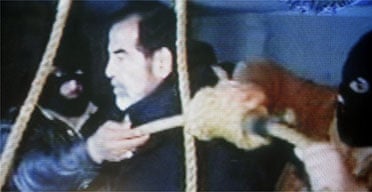Saddam Hussein was executed at dawn today following his conviction by an Iraqi court for crimes against humanity.
The death sentence was carried out at a former military intelligence headquarters in a Shia district of Baghdad at 6am local time (3am GMT).
One of those who witnessed the hanging, Sami al-Askari, an adviser to the Iraqi prime minister, said Saddam struggled when he was taken from his cell in a US military prison but was composed in his last moments. He expressed no remorse.
The former dictator, dressed in black, refused a hood and said he wanted the Koran he carried to the gallows to be given to a friend. "Before the rope was put around his neck, Saddam shouted. 'God is great. The nation will be victorious and Palestine is Arab'," Mr Askari told the Associated Press.
Another witness, Mowaffak al-Rubaie, Iraq's national security advisor, said Saddam was "strangely submissive" in the execution chamber. "He was a broken man," he said. "He was afraid. You could see fear in his face."
In a prepared statement, George Bush cautioned that Saddam's execution would not stop the violence in Iraq but said it was "an important milestone on Iraq's course to becoming a democracy that can govern, sustain and defend itself, and be an ally in the war on terror."
The office of the Iraqi prime minister, Nuri al-Maliki, released a statement that said Saddam's execution was a "strong lesson" to ruthless leaders who commit crimes against their own people. The Iraqi state broadcaster, Iraqiya, later aired film of the lead-up to the execution but not the hanging itself.
Saddam's execution was followed by reports of a car bombing with as many as 30 dead in the Shia city of Kufa.
In Sadr City, a major Shia area in Baghdad, people danced in the streets while others fired guns in the air to celebrate. The government did not impose a round-the-clock curfew as it did last month when Saddam was convicted.
The execution, which became imminent after his appeal was this week rejected, brought to an end the life of one of the Middle East's most brutal dictators.
Launching the 1980-88 Iran-Iraq war, campaigns against the Kurds and putting down the southern Shia revolt that followed the 1991 Gulf war - triggered by his invasion of Kuwait - put the casualties attributable to his rule into the hundreds of thousands.
But the conviction that led to his hanging was for a relatively lower figure - the deaths of 148 men and boys from the Shia town of Dujail, where members of an opposition group had made a botched attempt to assassinate him in 1982.
In Iraq opinion was divided sharply along sectarian lines, with Sunni Muslims warning of "bloodbaths in the streets".
Even among Shia Muslims, terrorised for decades by Saddam, there was a sense of hopelessness. "They can kill him 10 times but it won't bring safety to the streets because there is no state of law," said one Shia taxi driver who gave his name as Shawkat.
In the Kurdish north, jubilation was tempered by the fear of deeper sectarian tensions and disappointment that Saddam would now not be able to stand trial for other charges including the gas attack on the town of Halabja that killed 5,000 people in 1988.
"It would have been much better for the execution to have taken place in Halabja, not in Baghdad," said Barham Khorsheed, a Kurd.
Many critics dismissed the conduct of the trial and Saddam Hussein's defence team had accused the Iraqi government of interfering in the proceedings. The latter complaint was backed by the US-based Human Rights Watch.
The process that ended with his execution began with the launch of the 2003 US-led war to disarm Iraq's claimed weapons of mass destruction.
Mr Bush committed the US to a policy of regime change and Saddam was ousted within weeks of the invasion. Just over eight months later, US forces captured him from his hiding place in a hole near his hometown of Tikrit.
Paul Bremer, the US civilian administrator in Iraq, told a press conference: "We got him". For the first time, he showed video footage of a dishevelled former dictator, with unkempt hair and beard, being inspected by military doctors.
His rise was through the Ba'ath party. The party, which had participated in previous coups against Iraqi governments, took complete power in 1968.
Saddam was deputy president and regime strongman, responsible for internal security. But used his position to build a powerbase allowing him to supplant Ahmed Hassan al-Bakr as president in 1979. On taking power he launched a massive purge of the party.
Iraq under Saddam was under the thuggish rule of the dictator and, frequently, his relatives and cronies from Tikrit.
Saddam Hussein's half-brother, Barzan al-Tikriti, and Iraq's former chief judge, Awad Hamed al-Bandar, were also sentenced to death at the close of the Dujail trial.
Iraqiya television initially reported the two were also hanged today but officials later said only Saddam was executed.
